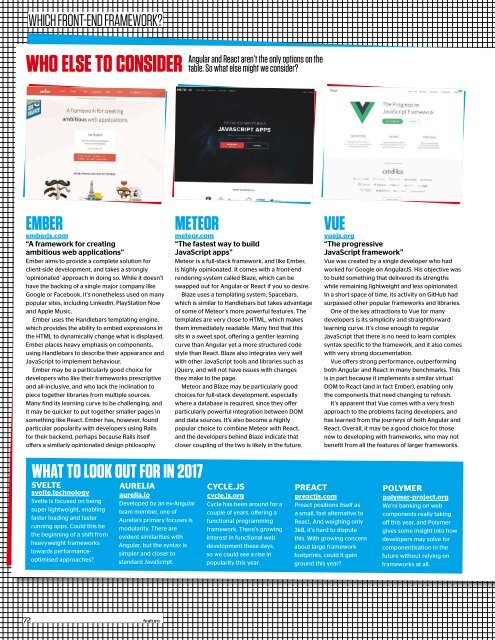Web_Designer_Issue_262_2017
You also want an ePaper? Increase the reach of your titles
YUMPU automatically turns print PDFs into web optimized ePapers that Google loves.
Which front-end frameWork?<br />
WHO ELSE TO CONSIDER<br />
Angular and React aren’t the only options on the<br />
table. So what else might we consider?<br />
EMBER<br />
emberjs.com<br />
“A framework for creating<br />
ambitious web applications”<br />
Ember aims to provide a complete solution for<br />
client-side development, and takes a strongly<br />
‘opinionated’ approach in doing so. While it doesn’t<br />
have the backing of a single major company like<br />
Google or Facebook, it’s nonetheless used on many<br />
popular sites, including LinkedIn, PlayStation Now<br />
and Apple Music.<br />
Ember uses the Handlebars templating engine,<br />
which provides the ability to embed expressions in<br />
the HTML to dynamically change what is displayed.<br />
Ember places heavy emphasis on components,<br />
using Handlebars to describe their appearance and<br />
JavaScript to implement behaviour.<br />
Ember may be a particularly good choice for<br />
developers who like their frameworks prescriptive<br />
and all-inclusive, and who lack the inclination to<br />
piece together libraries from multiple sources.<br />
Many find its learning curve to be challenging, and<br />
it may be quicker to put together smaller pages in<br />
something like React. Ember has, however, found<br />
particular popularity with developers using Rails<br />
for their backend, perhaps because Rails itself<br />
ofers a similarly opinionated design philosophy.<br />
WHAT TO LOOK OUT FOR IN <strong>2017</strong><br />
SVELTE<br />
svelte.technology<br />
Svelte is focused on being<br />
super lightweight, enabling<br />
faster loading and faster<br />
running apps. Could this be<br />
the beginning of a shift from<br />
heavyweight frameworks<br />
towards performanceoptimised<br />
approaches?<br />
AURELIA<br />
aurelia.io<br />
Developed by an ex-Angular<br />
team member, one of<br />
Aurelia’s primary focuses is<br />
modularity. There are<br />
evident similarities with<br />
Angular, but the syntax is<br />
simpler and closer to<br />
standard JavaScript.<br />
METEOR<br />
meteor.com<br />
“The fastest way to build<br />
JavaScript apps”<br />
Meteor is a full-stack framework, and like Ember,<br />
is highly opinionated. It comes with a front-end<br />
rendering system called Blaze, which can be<br />
swapped out for Angular or React if you so desire.<br />
Blaze uses a templating system, Spacebars,<br />
which is similar to Handlebars but takes advantage<br />
of some of Meteor’s more powerful features. The<br />
templates are very close to HTML, which makes<br />
them immediately readable. Many find that this<br />
sits in a sweet spot, ofering a gentler learning<br />
curve than Angular yet a more structured code<br />
style than React. Blaze also integrates very well<br />
with other JavaScript tools and libraries such as<br />
jQuery, and will not have issues with changes<br />
they make to the page.<br />
Meteor and Blaze may be particularly good<br />
choices for full-stack development, especially<br />
where a database is required, since they ofer<br />
particularly powerful integration between DOM<br />
and data sources. It’s also become a highly<br />
popular choice to combine Meteor with React,<br />
and the developers behind Blaze indicate that<br />
closer coupling of the two is likely in the future.<br />
CYCLE.JS<br />
cycle.js.org<br />
Cycle has been around for a<br />
couple of years, ofering a<br />
functional programming<br />
framework. There’s growing<br />
interest in functional web<br />
development these days,<br />
so we could see a rise in<br />
popularity this year.<br />
PREACT<br />
preactjs.com<br />
VUE<br />
vuejs.org<br />
“The progressive<br />
JavaScript framework”<br />
Vue was created by a single developer who had<br />
worked for Google on AngularJS. His objective was<br />
to build something that delivered its strengths<br />
while remaining lightweight and less opinionated.<br />
In a short space of time, its activity on GitHub had<br />
surpassed other popular frameworks and libraries.<br />
One of the key attractions to Vue for many<br />
developers is its simplicity and straightforward<br />
learning curve. It’s close enough to regular<br />
JavaScript that there is no need to learn complex<br />
syntax specific to the framework, and it also comes<br />
with very strong documentation.<br />
Vue ofers strong performance, outperforming<br />
both Angular and React in many benchmarks. This<br />
is in part because it implements a similar virtual<br />
DOM to React (and in fact Ember), enabling only<br />
the components that need changing to refresh.<br />
It’s apparent that Vue comes with a very fresh<br />
approach to the problems facing developers, and<br />
has learned from the journeys of both Angular and<br />
React. Overall, it may be a good choice for those<br />
new to developing with frameworks, who may not<br />
benefit from all the features of larger frameworks.<br />
Preact positions itself as<br />
a small, fast alternative to<br />
React. And weighing only<br />
3kB, it’s hard to dispute<br />
this. With growing concern<br />
about large framework<br />
footprints, could it gain<br />
ground this year?<br />
POLYMER<br />
polymer-project.org<br />
We’re banking on web<br />
components really taking<br />
of this year, and Polymer<br />
gives some insight into how<br />
developers may solve for<br />
componentisation in the<br />
future without relying on<br />
frameworks at all.<br />
72 ________________________________________________________________ feature


















